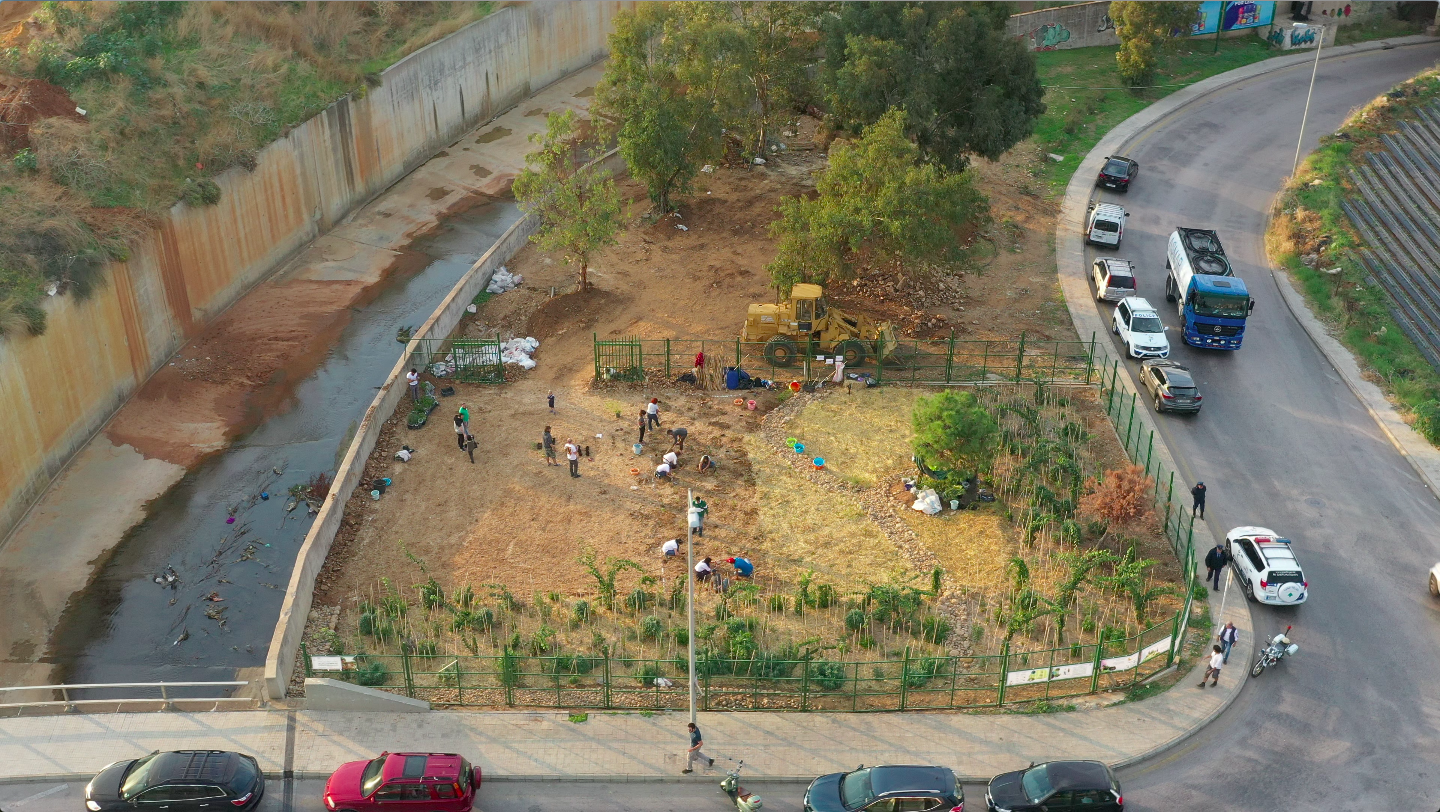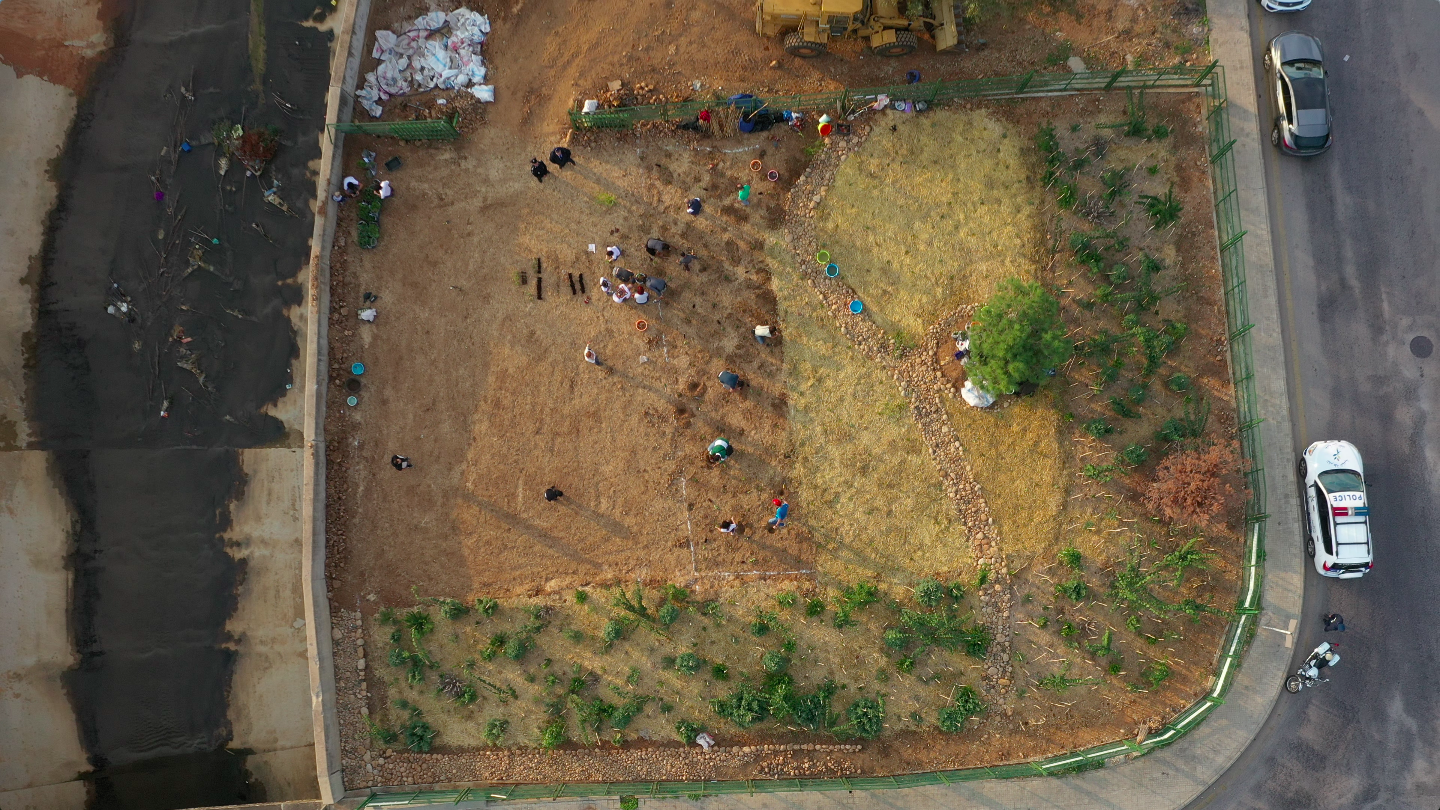Overview
Beirut has only 0.8 sqm of green space/capita, versus the WHO recommended 9 sqm/capita. The Beirut River is an Important Bird Area (IBA 4), it is undoubtedly one of the most important areas for bird migration in Lebanon, with important threatened species relying on the valley during spring migration. Due to the deteriorating condition of the Beirut River watershed especially in the city, we have seen a major loss of wildlife and insect habitat downstream the river. After 6 months of the first forest implementation, we already started to see native fauna coming back to live in the newly established ecosystem.
For the Beirut RiverLESS Urban Forest, we visited a native established forest upstream within the Beirut River watershed to conduct a botanical survey of the native species living in the forest. We then planted 17 available species of the 25 surveyed species in our plot adjacent to the river to bring back the native forest ecosystem into the city.
Forests connect across boundaries, watersheds and ecosystems and are not defined by cultural and political boundaries. Within 3 months the forest transformed into a transition space between the city and the native ecosystem, connecting humans and other organisms.
Quick Facts
Geographic Region:
Middle East
Country or Territory:
Lebanon
Biome:
Temperate Forest
Ecosystem:
Temperate Forest - Mixed
Area being restored:
0.2 hectares
Project Lead:
theOtherDada
Organization Type:
Private Company
Project Partners:
Afforestt
SUGi Project
Project Stage:
Post-Implementation Maintenance
Start Date:
2019-03
End Date:
2021-03
Primary Causes of Degradation
Fragmentation, Invasive Species (native or non-native pests, pathogens or plants), Urbanization, Transportation & IndustryDefining the Reference Ecosystem
The reference ecosystem is primarily based on contemporary reference sites or existing analogues of the pre-degradation ecosystem.Project Goals
Reclaiming urban landfills through urban afforestation, hence regenerating biodiversity, restoring the water cycle, and providing shared space for humans and other organisms.
Monitoring
Monitoring Details:
Monthly pictures
Monthly growth report on a selected sample of saplings planted
Bi-monthly visits and maintenance sessions
Start date, including baseline data collection:
2019-06
End Date:
2023-06
Stakeholders
Municipality of Sin El Fil
Local community and residents
How this project eliminated existing threats to the ecosystem:
Physical encroachment and vandalism through the installation of a temporary fence, to be removed after forest is successfully established
Removal of aggressive invasive tree species [Eucalyptus tree]
How this project reinstated appropriate physical conditions (e.g. hydrology, substrate)",:
- restoring organic matter to the soil through compost and organic matter addition
- inoculating soil with beneficial microorganisms and fungal ecosystem through preparation of locally-produced compost-tea with mature forest soil
How this project achieved a desirable species composition:
Potential Natural Vegetation study of the closest natural mature forest located upstream of our site
Based on the Miyawaki afforestation method, we identified 25 species of native trees and shrubs, the density we observed, as well as noted the proportions in which they exist in relation to each other. This composition is then calculated depending on our area of regeneration.
How this project reinstated structural diversity (e.g. strata, faunal food webs, spatial habitat diversity):
We have included the four levels of the mature forest ecosystem; canopy layer, tree, sub-tree and shrub layer
Spatial diversity in our randomized, non-linear planting pattern, as well as density observed in the mature forest.
We have inoculated the soil with beneficial microorganisms and fungal ecosystem through preparation of locally-produced compost-tea with mature forest soil
Ecological Outcomes Achieved
Eliminate existing threats to the ecosystem:
The fence has been effective in keeping out unwanted visitors, and protecting the saplings from vandalism and encroachment
Eliminated invasive species have not returned
Reinstate appropriate physical conditions",:
Previously dead soil is now full of life, insect, microbial and fungal networks reestablished
Soil retaining moisture properly
Achieve a desirable species composition:
All different species planted have survived.
Survival rate is 74%
Factors limiting recovery of the ecosystem:
fragmentation caused by roads and river concrete channel
Socio-Economic & Community Outcomes Achieved
Economic vitality and local livelihoods:
N/A
Provision of basic necessities such as food, water, timber, fiber, fuel, etc.:
N/A
Cultural dimensions such as recreational, aesthetic and/or spiritual:
Great, engaging and empowering local communities to join and demand reclamation of urban landfills, involving volunteers and residents through preparation, planting and maintenance activities
Regulation of climate, floods, disease, erosion, water quality, etc.:
Achieved a positive impact on reducing flooding and erosion
Has the project had any negative consequences for surrounding communities or given rise to new socio-economic or political challenges?:
No
Long-Term Management
As per the Miyawaki method, management [watering, de-weeding, rope-tying, mulching, compost-tea making] will be put in place for 2-3 years only, after which the forest is well established and self-sufficient, not requiring any type of management.
Other Resources
https://theotherdada.com/en/afforestation/412/beirut-river-urban-afforestation?nid=402
Primary Contact
Name:
Adib Dada
Affiliation:
Project initiator - implementation
City:
Beirut



